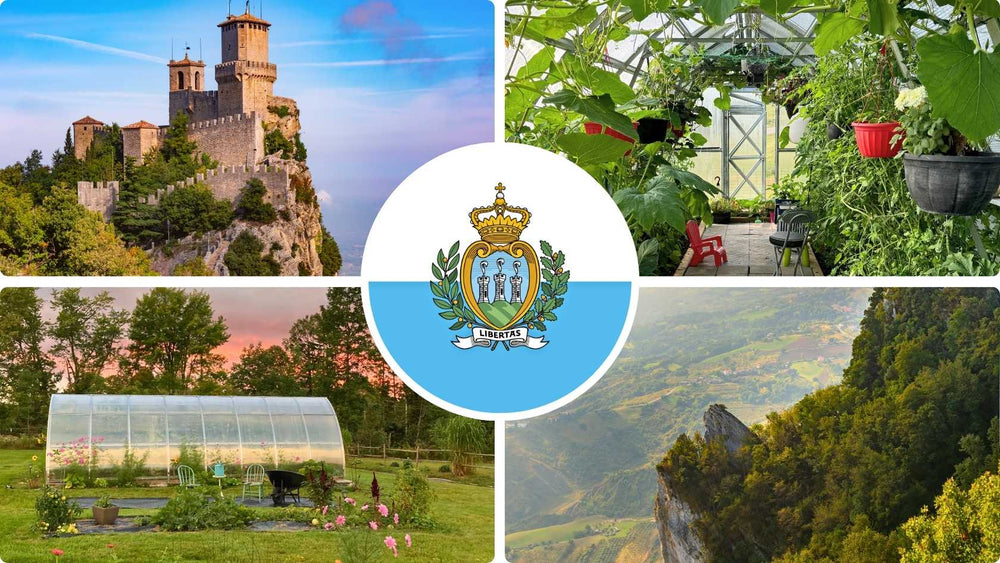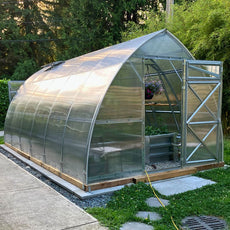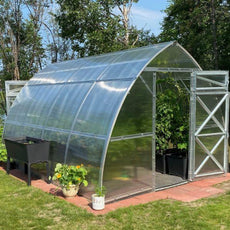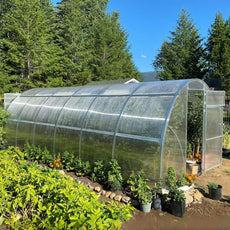In this article, you will learn:
- Characteristics of San Marino’s Growing Regions
- Challenges of Gardening in San Marino
- The Benefits of Using a Greenhouse in San Marino
San Marino’s gardening zones generally fall between 8a and 9a, reflecting its mild winters and warm summers. This temperate climate, combined with the country’s elevation and topography, creates microclimates that support the growth of various plants, from hardy Mediterranean staples to more delicate crops that thrive under controlled conditions.

Image from Plant Maps
Characteristics of San Marino’s Growing Regions
San Marino’s climate is predominantly Mediterranean, characterized by hot summers and mild winters. However, its hilly terrain introduces variations in temperature and precipitation, influencing gardening practices:
- Mild winters with average temperatures between 3°C and 8°C
- Warm summers with temperatures ranging from 20°C to 30°C, occasionally reaching 35°C
- Moderate rainfall, with most precipitation occurring in autumn and spring
- There is a low risk of frost, though occasional early spring or late autumn frosts may occur in higher elevations
- Long growing season, typically spanning from March to November
These conditions make San Marino a haven for gardeners seeking to grow a mix of Mediterranean and continental crops. However, the climate presents challenges that require attention, particularly in managing water availability during dry summers and protecting sensitive plants from temperature extremes.
Challenges of Growing in San Marino
Uneven Water Distribution
San Marino’s Mediterranean climate can lead to extended dry periods during summer, stressing plants and requiring efficient irrigation systems. Rainfall is more frequent in spring and autumn, but it is often insufficient to meet crops' water needs in the hotter months.
Spring and Autumn Frosts
While rare, occasional frosts in early spring or late autumn can damage young plants or extend the time needed for outdoor planting in higher altitudes.
Summer Heat Waves
High summer temperatures, often coupled with dry conditions, can stress crops and increase water requirements, particularly for non-native or more water-intensive plants.

The Benefits of Using a Greenhouse in San Marino
Greenhouses offer an ideal solution for San Marino’s gardeners, providing a controlled environment to counteract challenges such as uneven rainfall, frost, and summer heat waves. Using greenhouses, you can extend your growing season, diversify your cultivated crops, and protect plants from adverse weather conditions.
Extend Your Growing Season
- Without a greenhouse:
San Marino’s outdoor growing season typically lasts from March to November. While this is relatively long, it can limit the cultivation of certain heat-loving vegetables and fruits that require more stable conditions.
- With a greenhouse:
A greenhouse in San Marino can extend the growing season significantly, enabling year-round cultivation for some crops. This is particularly useful for growing vegetables and fruits sensitive to cooler temperatures or requiring consistent warmth to thrive.

Grow a Wider Variety of Vegetables
- Without a greenhouse:
San Marino’s gardeners often focus on Mediterranean staples and traditional crops well-suited to the local climate, such as:
|
Tomatoes Olives Grapes Figs Basil Rosemary Oregano |
Zucchini Artichokes Beans Garlic Onions Thyme |
- With a Greenhouse:
Greenhouses allow gardeners to expand their repertoire to include more exotic or delicate crops, such as:
|
Bell peppers Chili peppers Eggplants Melons (cantaloupes, watermelons) Citrus fruits (lemons, limes, oranges) Strawberries |
Peaches Nectarines Cucumbers Spinach Arugula Kale Passion fruit |
Exotic herbs (cilantro, lemongrass) Tropical fruits (bananas, guavas) Salad greens (lettuce, endives, radicchio) |





